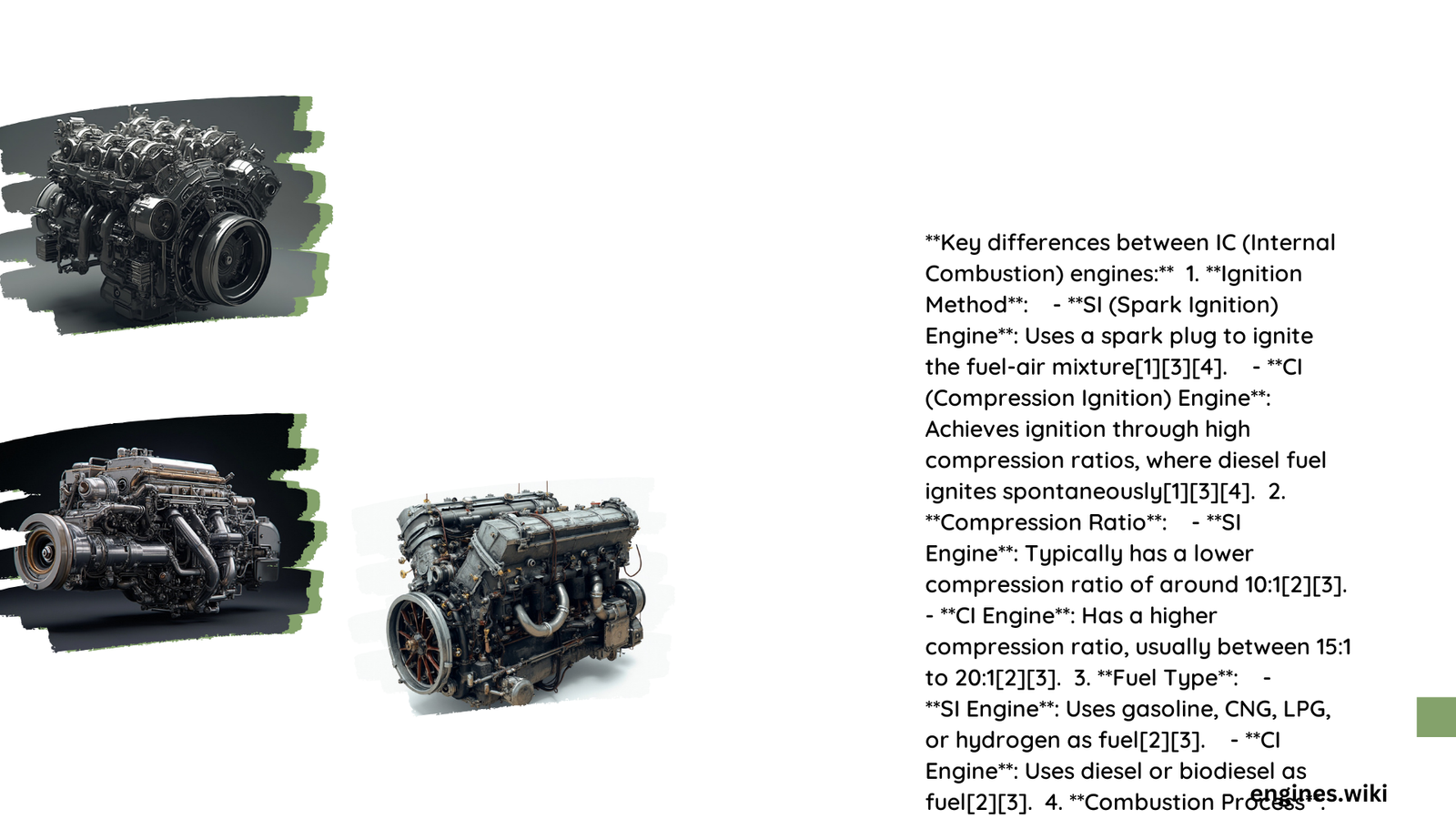The main difference between IC (Internal Combustion) engine and CI (Compression Ignition) engine lies in their ignition methods and fuel types. IC engines, also known as spark ignition (SI) engines, use spark plugs to ignite a pre-mixed air-fuel mixture, typically gasoline. CI engines, on the other hand, rely on high compression to ignite the fuel, usually diesel, without a spark plug. This fundamental difference leads to variations in efficiency, performance, and emissions between the two engine types.
What Are the Key Differences in Combustion Processes?
Spark Ignition (SI) Engines
- Ignition Method: Uses spark plug to ignite pre-mixed air-fuel mixture
- Compression Ratio: Typically 8-12
- Combustion Process: Controlled explosion initiated by spark
Compression Ignition (CI) Engines
- Ignition Method: Relies on high compression to ignite fuel
- Compression Ratio: Typically 14-22
- Combustion Process: Autoignition due to high temperature and pressure
How Do Fuel Types Differ Between IC and CI Engines?

| Characteristic | Gasoline (SI Engines) | Diesel (CI Engines) |
|---|---|---|
| Energy Density | ~44.4 MJ/kg | ~45.4 MJ/kg |
| Volatility | High | Low |
| Ignition Temperature | Lower | Higher |
| Combustion Speed | Faster | Slower |
What Are the Efficiency and Performance Differences?
Thermal Efficiency
- SI Engines: 25-30%
- CI Engines: 30-40%
Torque Output
- SI Engines: Lower torque at low RPMs
- CI Engines: Higher torque at low RPMs
Horsepower Ratings
- SI Engines: Higher maximum power at high RPMs
- CI Engines: Superior sustained power and efficiency at lower RPMs
What Are the Challenges and Advantages of Each Engine Type?
Maintenance Costs
- SI Engines:
- Lower overall maintenance costs
-
More frequent spark plug replacements
-
CI Engines:
- Higher maintenance costs due to complex fuel injection systems
- More wear and tear on engine components
Emissions Levels
- SI Engines:
- Lower NOx emissions
- Higher HC and CO emissions
-
Fewer particulate matter emissions
-
CI Engines:
- Higher NOx emissions
- Lower HC and CO emissions
- More particulate matter emissions (mitigated by modern technologies)
Operational Lifespan
- SI Engines: Generally shorter lifespan due to higher RPMs and potential for engine knock
- CI Engines: Known for durability and reliability, often lasting hundreds of thousands of miles
How Do Applications Differ Between IC and CI Engines?
SI Engine Applications
- Passenger vehicles
- Motorcycles
- Small boats
- Lawn mowers
- Portable generators
CI Engine Applications
- Heavy-duty trucks
- Buses
- Construction equipment
- Large ships
- Industrial generators
What Are the Future Trends for IC and CI Engines?
SI Engine Trends
- Increased use of direct fuel injection
- Development of homogeneous charge compression ignition (HCCI) engines
- Integration with hybrid powertrains
CI Engine Trends
- Advancements in common rail injection systems
- Implementation of selective catalytic reduction (SCR) for emissions control
- Exploration of alternative fuels like biodiesel and synthetic diesel
In conclusion, while both IC (SI) and CI engines have their unique advantages and applications, ongoing technological advancements continue to blur the lines between these two engine types. The choice between an IC or CI engine ultimately depends on the specific requirements of the application, considering factors such as efficiency, performance, emissions, and operational costs.
References:
1. https://www.differencebetween.com/difference-between-spark-ignition-and-vs-compression-ignition/
2. https://www.merchantnavydecoded.com/spark-ignition-engine-vs-compressed-ignition-engine/
3. https://testbook.com/mechanical-engineering/difference-between-si-engine-and-ci-engine
